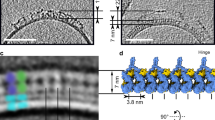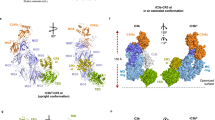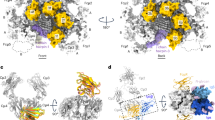Abstract
In humoral defence, pathogens are cleared by antibodies acting as adaptor molecules: they bind to antigen and trigger clearance mechanisms such as phagocytosis, antibody-dependent cell-mediated cytotoxicity and complement lysis1. The first step in the complement cascade is the binding of C1q to the antibody. There are six heads on C1q, connected by collagen-like stems to a central stalk2, and the isolated heads bind to the Fc portion of antibody rather weakly, with an affinity of 100 μM (ref. 3). Binding of antibody to multiple epitopes on an antigenic surface, aggregates the antibody and this facilitates the binding of several C1q heads4, leading to an enhanced affinity of about 10 nM (ref. 1). Within the Fc portion of the antibody, C1q binds to the CH2 domain5,6. The interaction is sensitive to ionic strength7, and appears to be highly conserved throughout evolution as C1q reacts with IgG from different species (for example see ref. 8). By systematically altering surface residues in the mouse IgG2b isotype, we have localized the binding site for C1q to three side chains, Glu 318, Lys 320 and Lys 322. These residues are relatively conserved in other antibody isotypes, and a peptide mimic of this sequence is able to inhibit complement lysis. We propose that this sequence motif forms a common core in the interactions of IgG and C1q.
This is a preview of subscription content, access via your institution
Access options
Subscribe to this journal
Receive 51 print issues and online access
$199.00 per year
only $3.90 per issue
Buy this article
- Purchase on Springer Link
- Instant access to full article PDF
Prices may be subject to local taxes which are calculated during checkout
Similar content being viewed by others
References
Burton, D. R. Molec. Immun. 22, 161–206 (1985).
Reid K. B. M. & Porter, R. R. Biochem. J. 155, 19–23 (1976).
Hughes-Jones, N. C. & Gardner, B. Molec Immun. 16, 697–701 (1979).
Metzger, H. in Contemporary topics in Molecular Immunology 7, 119 (Plenum, New York, 1978).
Yasmeen, D., Ellerson, J. R., Dorrington, K. J. & Painter R. H. J. Immun. 116, 518–522 (1976).
Colomb, M. & Porter, R. R. Biochem. J. 145, 177–183 (1975).
Burton, D. R. et al. Nature 288, 338–344 (1980).
Alexander, R. J. & Steiner, L. A. Molec. Immun. 17, 1263–1273 (1980).
Bedouelle, H. & Winter, G. Nature 320, 371–373 (1986).
Neuberger, M. S. & Williams, G. T. Phil. Trans. R. Soc. A 317, 425–432 (1986).
Koide, N., Nose, M. & Muramatsu, T. Biochem. biophys. Res. Commun. 75, 838–844 (1977).
Nose, M. & Wigzell, Proc. natn. Acad. Sci. U.S.A. 80, 6632–6636 (1973).
Leatherbarrow, R. J. & Dwek, R. A. FEBS Lett. 164, 227–230 (1983).
Leatherbarrow, R. J. et al. Molec. Immun. 22, 407–415 (1985).
Oi, V. T. et al. Nature 307, 136–140 (1984).
Isenman, D. E., Dorrington, K. J. & Painter, P. H. J. Immun. 114, 1726–1729 (1975).
van der Zee, J. S., van Swieten, P. & Aalberse, R. C. Clin. exp. Immun. 64, 415–422 (1986).
Prystowsky, M. B., Kehoe, M. & Erickson, B. W. Biochemistry 20, 6349–6356 (1981).
Boackle, R. J., Johnson, B. J. & Caughman, G. B. Nature 282, 742–743 (1979).
Lukas, T. J., Munos, H. & Erickson, B. W. J. Immun. 127, 2555–2560 (1981).
Reid, K. B. M., Gagnon, J. & Framton, J. biochem. J. 203, 559–569 (1982).
Cooper, N. R., Jensen, F. C., Welsh, R. M. & Oldstone, M. B. A. J. exp. Med. 144, 970–984 (1976)
Deisenhofer, J. Biochemistry 20, 2361–2370 (1981).
Brunhouse, R. & Cebra, J. J. Molec. Immun. 16, 907–917 (1979).
Weltzien, H. U., Matthiessen, H. P., Meyer-Delius, M., Zimmermann, F. & Rude, E. Molec. Immun. 21, 801–810 (1984).
Carter, P., Bedouelle, H. & Winter, G. Nucleic Acids Res. 13, 4431–4443 (1985).
Neuberger, M. S., Williams, G. T. & Fox, R. O. Nature 312, 604–608 (1984).
Campbell, A. M. Monoclonal Antibody Technology (Elsevier, Amsterdam, New York, Oxford, 1984).
Leatherbarrow, R. J. & Dwek, R. A. Molec. Immun. 21, 321–327 (1984).
Author information
Authors and Affiliations
Rights and permissions
About this article
Cite this article
Duncan, A., Winter, G. The binding site for C1q on IgG. Nature 332, 738–740 (1988). https://doi.org/10.1038/332738a0
Received:
Accepted:
Issue Date:
DOI: https://doi.org/10.1038/332738a0
This article is cited by
-
Flower-like WSe2 used as bio-matrix in ultrasensitive label-free electrochemical immunosensor for human immunoglobulin G determination
Analytical Sciences (2023)
-
Engineered DNA-encoded monoclonal antibodies targeting Plasmodium falciparum circumsporozoite protein confer single dose protection in a murine malaria challenge model
Scientific Reports (2022)
-
An Fc variant with two mutations confers prolonged serum half-life and enhanced effector functions on IgG antibodies
Experimental & Molecular Medicine (2022)
-
Cross-reactive, natural IgG recognizing L. major promote parasite internalization by dendritic cells and promote protective immunity
Journal of Molecular Medicine (2022)
-
C3 complement inhibition prevents antibody-mediated rejection and prolongs renal allograft survival in sensitized non-human primates
Nature Communications (2021)
Comments
By submitting a comment you agree to abide by our Terms and Community Guidelines. If you find something abusive or that does not comply with our terms or guidelines please flag it as inappropriate.



